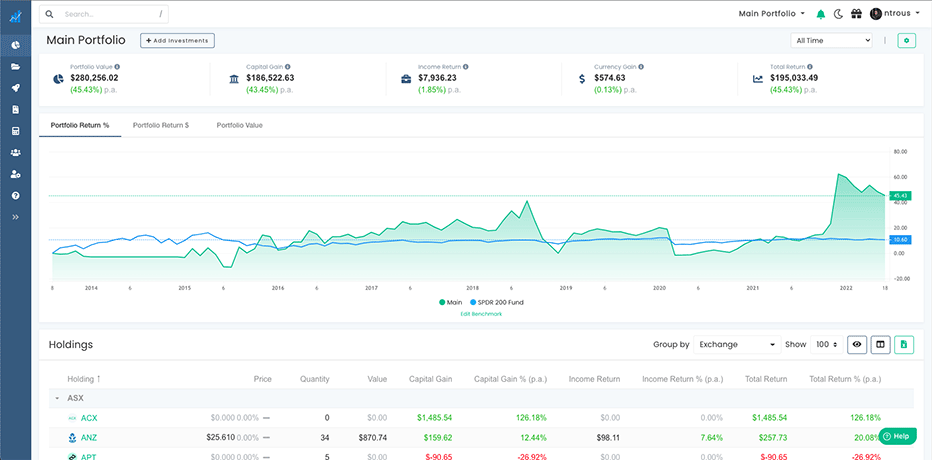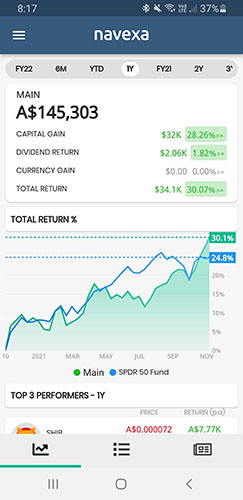Australian Fund Comparison Tool
Quickly compare the historical performance of ASX-listed ETFs and managed funds.
How to use the Australian Fund Comparison Tool:
Search and select the ticker symbol (e.g. IVV) for the fund you want to calculate performance for and compare. Click ‘add fund’, then repeat for up to four funds.
What does the Australian Fund Comparison Tool show?:
In the table, you’ll see the one, three, five and 10-year total performance calculations for the funds you select — up to the current date. You’ll also see the three and five-year standard deviation for each fund.
More about ETFs and managed funds
How do ETFs work in Australia?
ETFs in Australia operate as investment funds traded on the stock exchange. They typically track an index, commodity, or basket of assets.
Investors can buy and sell ETF shares like stocks, providing diversification and flexibility. The fund's net asset value (NAV) is closely tied to the underlying assets, and prices fluctuate throughout the trading day.
This structure allows investors to gain exposure to various assets without directly owning them, making ETFs a convenient and cost-effective investment option.
What are the top ETFs in Australia?
Popular ETFs in Australia cover a range of asset classes. ASX-listed funds like Vanguard Australian Shares ETF (VAS), iShares S&P/ASX 200 ETF (IOZ), and BetaShares Australia 200 ETF (A200) are frequently discussed.
Investors often consider factors such as expense ratios, liquidity, and the specific index or sector the ETF tracks when determining the best fit for their portfolio.
What are the tax implications of investing in ETFs in Australia?
Tax implications for ETFs in Australia include capital gains tax (CGT) on the sale of units and potential tax on dividends. The tax treatment can vary based on factors such as the investor's holding period and the nature of the distribution.
Holding ETFs in tax-efficient structures like self-managed superannuation funds (SMSFs) or considering tax-loss harvesting strategies can be part of a tax-efficient ETF investment approach. It's advisable for investors to consult with tax professionals for personalized advice.
How do managed funds work in Australia?
Managed funds pool money from various investors to create a diversified portfolio managed by professional fund managers. Investors purchase units in the fund, representing a share of the overall portfolio.
Fund managers make investment decisions on behalf of the investors, aiming to achieve the fund's stated objectives. The fund's value, reflected in its net asset value (NAV), fluctuates based on the performance of its underlying assets. Investors can buy and sell units at the prevailing NAV.
What are the top-performing managed funds in Australia?
Identifying top-performing managed funds involves assessing historical performance, risk metrics, and the fund manager's strategy. Funds like AustralianSuper, Vanguard Australian Shares Index, and Magellan Global Fund are often considered by investors.
However, past performance is not indicative of future results, and individual preferences and risk tolerance play a crucial role in fund selection.
What are the fees and charges associated with managed funds in Australia?
Managed funds in Australia typically charge management fees, which cover the costs of fund management and administration. Additionally, performance fees may apply if the fund outperforms predefined benchmarks.
Investors should also be aware of entry and exit fees. Understanding the fee structure is essential for evaluating the total cost of investing in a managed fund and its impact on potential returns. Transparent disclosure of fees is a key aspect of fund management in Australia.
Disclaimer: This tool is provided for informational purposes only. It is not intended to be, nor does it constitute, investment advice or recommendations. Neither Navexa Pty Ltd nor any of its affiliates (collectively, “Navexa”) makes any guarantee or other promise as to any results that may be obtained from using this tool. Navexa is not responsible for any errors or omissions in performance data or calculations for any funds or indexes in this tool. Navexa makes no express or implied warranties of any kind regarding the data, including, without limitation, any warranty of merchantability or fitness for a particular purpose or use; and (b) shall not be liable for any errors, incompleteness, interruption or delay, action taken in reliance on any data, or for any damages resulting therefrom. Data may be intentionally delayed pursuant to supplier requirements.

